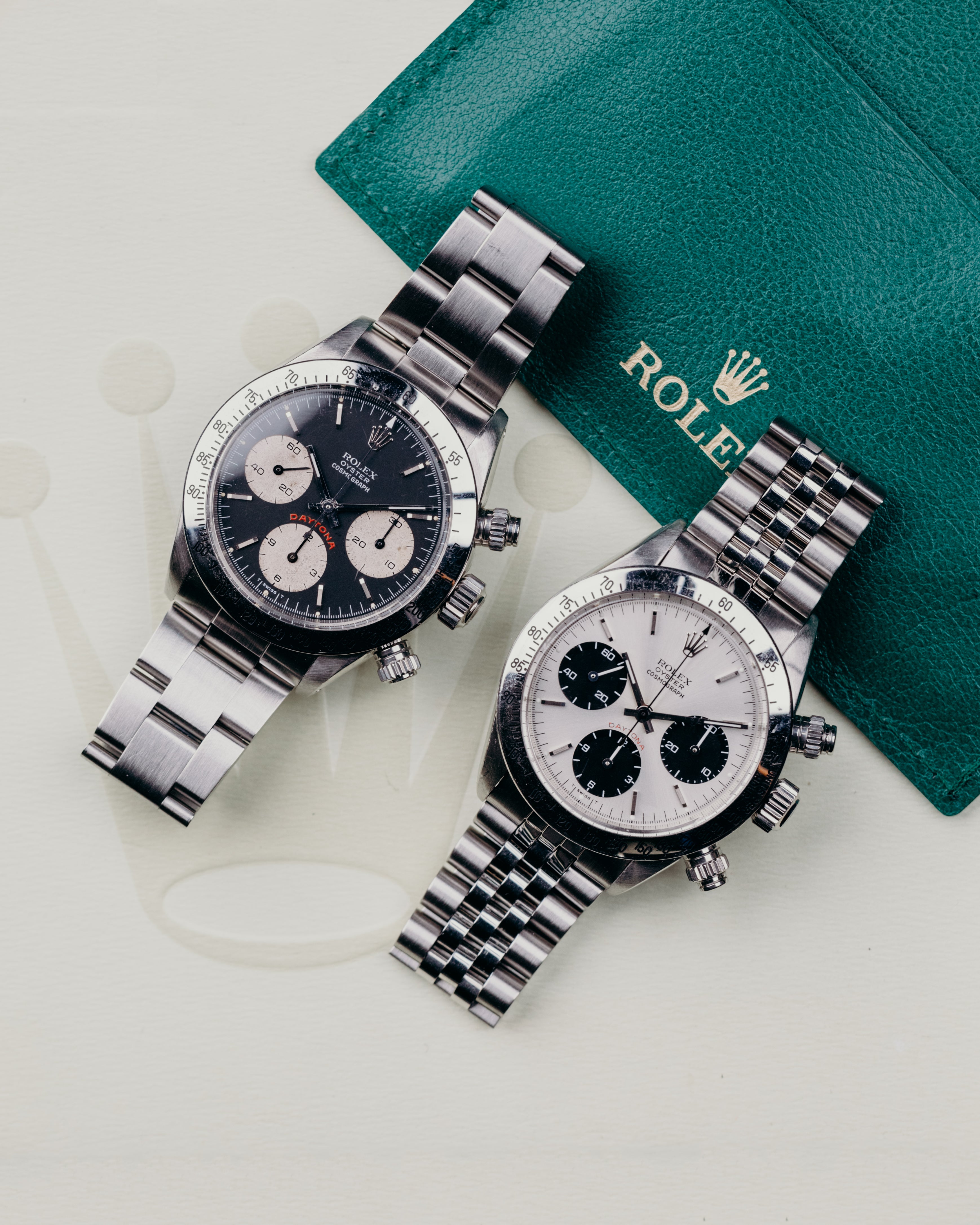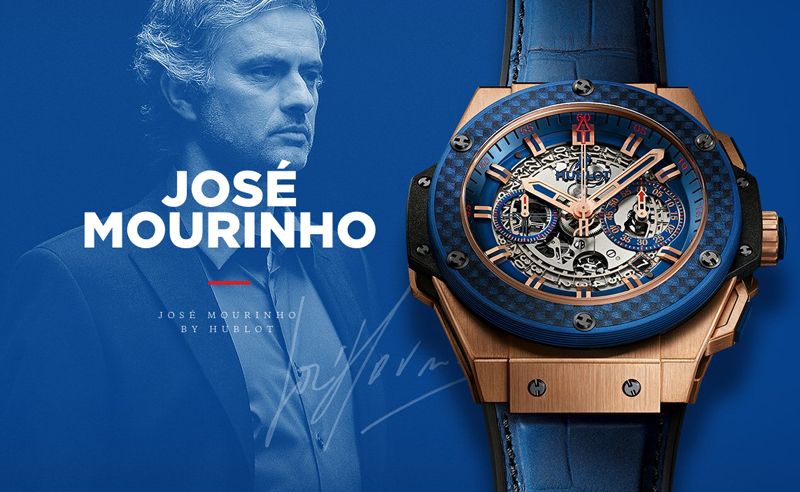
Paul Newman’s Rolex Daytona - The Story of an Icon
By Alan Boal
The story of a $17.8m Rolex, the superstar who wore it, and how it became more than just a watch.
It failed NASA’s ‘Moonwatch’ tests, wasn’t the first automatic chronograph and lacked a Rolex movement for almost 40 years, but today the Cosmograph Daytona is the jewel in Rolex’s crown, and in no small part that’s because of one man – Paul Newman.
Without the simple gift of a watch by a wife to her husband, that might not have been the case. Of course, it helps when in 2017 that Rolex sold at auction for a record-breaking $17.8m (£13.5m), and when the husband in question was Paul Newman - Oscar-winning screen legend, race car driver, activist, philanthropist, food entrepreneur, all-round icon.
And, in true Hollywood fashion, success usually produces a sequel: with a second Daytona owned by Newman to be auctioned on the 12th December, it’s a good time to revisit this record-breaking watch and its iconic former owner.
More Than Just a Watch
The rise of the ‘Newman Daytona’ to iconic status is a fascinating story in its own right. As news of the watch’s $17.8m sale (then the most expensive ever sold at auction) filtered into even mainstream media, it represented a landmark moment in watch collecting, and particularly the vintage watch investment boom, the effects of which continue to be felt today, with popular Rolex watches increasing in price and harder to come by than toilet roll during a Coronavirus lockdown.
But more than that, it’s a story about the power of watches to create strong and memorable emotional connections across decades – from a gift by a loving wife, to a father-figure’s reward for a young man, and then a headline-grabbing auction phenomenon of global interest.
It’s about how those watches today allow Newman’s daughters to continue to promote the memory, character and philanthropy of their father, releasing millions of dollars in auction proceeds for ongoing charitable works.
Ironically, Newman had no intention of promoting his watch, and nor was it pushed by Rolex.
A Racing Start
From the outset, the Daytona – named after the legendary Daytona International Speedway in Daytona Beach, Florida, with its world famous NASCAR ‘Daytona 500’ & ’24 Hours of Daytona’ races – was designed for, and associated with, motor racing.
Newman’s Daytona was photographed on his wrist on many occasions throughout the 1970’s & 1980’s – tellingly, it often had the protective screw-down chronograph pushers left unscrewed, as befits a racing man who needed instant access to the chronograph function on a regular basis.
A 1965 Rolex advert – then referring to the Chronograph Daytona, and not the Cosmograph – produced for the Howard Hawks film Red Line 7000, about stock-car racing, is further evidence of Rolex’s push to associate the watch with racing.
In 2013 Rolex became a Global Partner and Official Timepiece of Formula 1, perhaps the most famous and glamourous of all motor sports.
A Star of Track & Screen
Paid Brand Ambassadors are big business, and it’s hard to open a glossy lifestyle magazine without observing a Film ‘Star’ moodily staring back, awkwardly clasping a watch they’ve been paid to shill but probably don’t wear themselves, as they wonder what to spend their fat endorsement cheque on.
Paul Newman was different, the real deal: Hollywood Royalty, wearing a Daytona just because he liked it, and a race car driver using the watch at the track where it truly belonged. And Rolex didn’t pay a single cent for perhaps the greatest Ambassador they’ve ever had.
Whether it’s sporting a Submariner dive watch and pretending to be Jacques Cousteau braving the ocean depths, or James Bond fighting-off equal amounts of villains & girls, then who better than Paul Newman for inspiration, a man who was cooler than the other side of the pillow.
When not playing a Wild West outlaw in Butch Cassidy and the Sundance Kid, a pool shark in The Hustler, and battling fires in The Towering Inferno, Newman was a real life ‘action man’ behind the wheel.
This was no indulgent celebrity dalliance, Newman drove professionally – and to win.
Whilst Bullitt actor Steve McQueen may have starred in the 1971 film Le Mans, about the World's most famous & oldest endurance race, Newman actually competed in the event for real, finishing 2nd overall in 1979.
Strangely, for an actor nominated for an Oscar in five separate decades, Newman claimed racing “was the first thing that I ever found I had any grace in”. Amazingly, he didn’t even start racing until he was 43, after training for the fittingly-named 1969 film, Winning. That film also starred his Oscar-winning wife, Joanne Woodward, and who afterwards bought her husband a Rolex watch to time his track exploits.
Speeding his way to four USA National Championships and founding his own ‘Can-Am’ and ‘Indy Car’ racing team (hiring legendary drivers like Mario Andretti & Nigel Mansell), he was still behind the wheel at 70, entering the Guinness Book of Records to become the oldest winning driver in a sanctioned race at the 1995 ‘24 Hours of Daytona’ (yep, there’s that name again) and not hanging up his racing overalls until the grand old age of 81.
Even his last acting role was lending his voice to a race car in Disney’s computer-animated blockbuster, Cars.
The Gift of Time
Sometime around 1972 (reports differ as to the exact purchase date) Joanne Woodward was seeking a present for her husband, and in a New York ‘Tiffany’ store she purchased a stainless-steel Rolex Chronograph, model 6239, for about $300 and had the case back engraved with the words ‘Drive Carefully, Me’, in reference to Newman’s love of motor racing.
The watch featured an ‘exotic’ white dial with Art Deco-style numerals and black chronograph sub-dials depicting elapsed hours, minutes and running seconds. The chronograph function was the perfect ‘wrist computer’ for the race track, and Newman used it as it was meant to be.
The Ugly Duckling and an Italian Rediscovery
Rolex has had a long roll-call of celebrities, explorers & sporting stars that have been paid to appear in their advertisements, but Newman wore his Rolex without ever publicly endorsing the brand.
For their part, it was watch collectors who christened the model 6239 the ‘Paul Newman Daytona’ – it has never been referred to as such by Rolex themselves.
A Newman Daytona is a specific vintage variant of the wider Daytona range, not an entire line in itself, and only a few thousand were ever made, sporting an ‘exotic’ dial and deemed unpopular at the time.
Given enough time, a rarity of production plus consumer indifference is often a combination that inspires a delayed collectability in vintage Rolex watches, with high prices to match.
Rolex’s Daytona Chronograph debuted in 1963, but despite nowadays being the most sought-after model in the Rolex catalogue, the Daytona was not initially successful or loved.
There are accounts of watch dealers refusing to take Daytonas in trade, so unpopular were they at the time.
In order to be allowed the valued opportunity of buying the latest ‘hot’ models today – like the current ceramic Daytona – some authorised watch dealers expect buyers to also purchase a few of their less popular items too, thereby shifting them from their stock inventory. It’s ironic then, that decades ago there are tales of wearied retailers offering the unpopular Daytona for free as reward for the accompanying purchase of their more popular & expensive offerings. How things have changed.
In the 1960’s, watch buyers increasingly expected the supreme convenience of automatic-winding watches, which no longer required them to be laboriously hand-wound on a daily basis.
In 1969, the first automatic chronographs - i.e. self-winding by means of a rotating rotor weight built into the movement and which oscillates with motion to wind the mainspring, storing up power - had already been issued by Rolex’s competitors, so the Daytona, with its hand-wind only Valjoux Calibre 72 was quickly deemed a bit ‘old hat’, and languished gathering dust on watch shop shelves.
Of course, the ‘Perpetual’ moniker was coined by Rolex themselves in 1931 to advertise their patent for the first self-winding wristwatch movement with a perpetual rotor, and the ‘Perpetual’ name is still used throughout their range today.
It’s curious then, that a brand which placed such pride in automatic movements failed to introduce a self-winding Daytona until 1988.
Not only were Rolex late to the automatic chronograph party – the first examples of which were announced to great fanfare by Heuer, Seiko & Zenith in 1969 – but their automatic Daytona relied upon an ‘El Primero’ movement purchased from their competitor, Zenith, and not one manufactured by Rolex.
Given the credibility and cachet attributed today to self-sufficient ‘in-house’ production, it’s unthinkable that Rolex would do that nowadays. However, in many ways it was in keeping with Rolex traditions, as they started out as a company using Third Party movements, and in true Rolex fashion, they made a number of improving modifications to what they named ‘their’ Calibre 4030.
Testament to how unloved the manual-winding Daytona really was, a glance at a February 1985 Rolex UK price list shows it sold for £725, less than a Submariner (£849), Explorer II (£794) or GMT-Master (£885).
Clearly, something happened after that to elevate the Daytona to the jewel in Rolex’s crown, and it wasn’t just the belated inclusion of an automatic movement.
In no small part, the coronation of the Daytona was driven by its association with Paul Newman, but there are varying accounts of how & why Newman’s casual wearing of a previously unfancied tool watch later created a feted and sought-after collectable in vintage watch circles.
Italy has long been a hotbed of horology and vintage watch collecting, particularly mechanical chronographs, and it’s no coincidence that the advent of consumer watch magazines dedicated to mechanical timepieces was popularised in Italy during the late 1980’s.
One oft-repeated theory is that Newman was featured on the cover of a popular Italian magazine, which prominently displayed the Daytona on his wrist and inspired interest in the previously obscure model.
However, it seems unlikely that magazine cover alone would have propelled the 6239 Daytona to crest a wave of popularity and transform it into a million-dollar watch.
Perhaps the answer lies more generally with the growing interest in vintage watches in the aftermath of the so-called ‘Quartz Crisis’ of the 1970’s & early 1980’s, which witnessed a surging popularity in quartz watches that decimated the traditional mechanical watch industry.
As mechanical watches ceased to be ubiquitous everyman tools for telling the time, and were rendered obsolete by new quartz technology for other specialist technical purposes such as diving, racing, navigation etc., for survival in the 1980’s they were forced to reinvent themselves more as luxury items, feted for their heritage, engineering ‘soul’, craftsmanship and beauty. And also a perceived exclusivity and being ‘reassuringly expensive’, to quote a famous phrase. A mechanical watch’s purpose now went beyond simply keeping time.
As interest reignited in mechanical wristwatches generally, so did the collectability of vintage watches, especially those of rarity, and prices began to skyrocket. Add the celebrity cachet of the likes of Paul Newman into the mix, and suddenly the previously unloved vintage Daytona became cool and collectable.
Auction Records Smashed and the Vintage Watch Boom
The Newman Daytona smashed the previous auction record, set only a few months earlier in May 2017 by the $5m sale of the ‘Bao Dai’ Rolex.
The Bao Dai, reference 6062, is named after its original owner, the last Emperor of Vietnam, and is much more complex & rare than the Newman Daytona, boasting a triple calendar and moonphase display, crafted in 18 carat gold, and one of only three black-dial models ever known to have been made, and rendered utterly unique by its diamond markers.
Still, even all that finery couldn’t compete with the enduring star power of the ‘King of Cool’, Paul Newman.
When an otherwise unremarkable - albeit, relatively rare - watch sells for $17.8m, it’s because of pure emotion; the emotive pull created by the link with a superstar, an intangible, incalculable attraction that explains why watches have such a compelling hold over us.
If anything illustrates the super-heated explosion in vintage watch interest, then it’s the fact that the Bo Dai Rolex previously held the record of world’s most expensive watch in 2002, when it was auctioned for $235,000, but just 15 years later was sold for over 20 times that amount in 2017, before just five short months later being itself eclipsed by the Newman Daytona, which went for more than three times as much again.
In November 2019, the Newman Daytona was pushed into second place by the new record holder, a Patek Philippe Grandmaster Chime Ref. 6300A-010, which was auctioned for $31.19m.
It took until 2011 for the first vintage Rolex to break the $1m barrier at auction (that is, the first publicly-known sale – there are of course private sales between collectors), and as at the end of 2019, 12 of the 28 Rolex watches to have sold for over $1m were Daytona models.
The lure of celebrity provenance might have been ignited by Newman, but it didn’t stop with him - in 2019, a Rolex GMT-Master previously owned by Marlon Brando, and featured in the film Apocalypse Now, sold at $1.95m, and golf legend Jack Nicklaus’ Rolex Day-Date went for $1.22m.
The Daytona has long been a popular model for Rolex, but as vintage Daytonas started to make more headlines at auction, then so has the modern Daytona bandwagon gathered pace, culminating in the March 2016 ‘Baselworld’ release of the 116500 LN, with a ceramic bezel for the first time.
There’s an amusing economic symmetry between the record-breaking auction of Newman’s 1960’s watch, and the continuing above-RRP resale value of the modern Daytona today.
The Gift That Keeps on Giving
Despite its sale, the watch continues to play a large part in the Newman family today.
Whilst their relationship ended, James Cox remained close to both Nell Newman – he was the photographer at her wedding – and the Newman family. He was also already a long-time board member of the charitable Nell Newman Foundation set-up in 2010 by his ex-girlfriend to continue her father’s philanthropy, so it was to this organisation that he fittingly pledged a portion of the auction funds, neatly closing the circle of the watch’s story and returning the benefit of the generosity he received from Paul Newman decades earlier.
The Nell Newman Foundation awards charitable grants in areas such as the environment, education, emergency relief & animal welfare, and James Cox & Nell Newman continue to work together, supported by the auction proceeds of an unremarkable watch that later became something very special indeed.
A Blockbuster Hollywood Sequel?
Like all good Hollywood movies (and an awful lot of bad ones), success usually results in a sequel, and there is in fact yet another Rolex Daytona previously owned by Paul Newman which is up for auction by Phillips on Saturday 12th December in their New York ‘Racing Pulse’ event.
Note, whilst it is a Daytona that belonged to Paul Newman, it’s not actually a Paul Newman Daytona, i.e. a model 6239.
Newman’s youngest daughter, Clea Newman Soderlund, possesses a stainless-steel & black-dial model 6263 ‘Big Red’ - another gifted to Newman by his wife Joanne in the 1980’s, this time for their 25th wedding anniversary in 1983. Mrs Newman obviously believed in raising her gift game well beyond the woolly socks & ‘Brut’ aftershave typically received by husbands across the land.
Presumably Newman wasn’t a great listener either, as she again had the Rolex engraved with a similar caution as before: ‘Drive slowly. Joanne’ .
Clea recalls that her father wore the watch not just to the race track, but also to time her equestrian competitions: “He would always say that the timers at the horse shows weren’t as accurate as his watch.” He gifted the watch to Clea in 2008 whilst undergoing lung cancer treatment in hospital – “He just took it off his wrist and handed it to me and said, ‘I want you to have this’.”
Newman passed away in 2008, and Clea treasured the watch as a memento of her father. There is something truly special about a watch, that most highly personal of objects, that is capable of sustaining emotional connections between generations.
Clea had previously insisted that the precious heirloom wouldn’t be sold: “Pop wore this watch every day... I wear this every day as he did and I don't care what it's worth, outside that it's my connection to him.”
So what changed?
Well, like her sister Nell before her, Clea realised that the proceeds from sale could make a lasting charitable contribution, the sort her father dedicated his life to pursuing: “It’s hard to find a way to honour your parents well. This is one of the few ways I know that I can. This is just such a difficult time for the world. It just feels right.” Unsurprisingly, the sale also has the support of Clea’s sisters.
A portion of the money raised at auction – projected to be in excess of $1m – will go to many charities, including two founded by Paul Newman himself, the ‘SeriousFun Children’s Network’, and the ‘Safe Water Network’.
The First Person to Buy Paul Newman’s Daytona at an Auction was… Paul Newman Himself
One charitable, humble act speaks volumes about Paul Newman’s generosity, and also helps explain why his loved ones were inspired to continue his legacy of giving by auctioning his watches to benefit others.
In 1999, Antiquorum held their ‘Famous Faces’ auction, in which celebrities donated their personal watches for charity. The prime lot was Newman’s engraved 16520 Rolex Daytona, which he won as a prize for finishing top of the GT-1 Class at the Rolex-sponsored 1995 ‘24 Hours’ race held at the Daytona Speedway (where else?).
Although the winning bidder of $39,000 wished to remain anonymous, it was noticed in photos taken years later that Newman was still sporting an identical watch on his wrist – he had donated to quietly buy his own watch back again.
That anonymous, low-key good deed was typical of a man who burned his tuxedo on his front lawn so as to have an excuse to avoid attending any more celebrity awards ceremonies where he would again be the centre of attention, receiving yet another lifetime honour. (Incidentally, another of his tuxedos was given away by Joanne Woodward to none other than James Cox, who later wore that same tuxedo at a night to promote his Daytona auction).
Some things are more valuable than money, and Paul Newman believed that more than most.
Sure, the multi-million dollar auction prices may generate the splashy headlines, but ultimately, it’s the personal relationship between a special man, his family and his watches, imbued with his stories and personality, that makes the watches so emotionally compelling in the first place.
Not everyone can be lucky enough to possess a Daytona, let alone one previously owned by Paul Newman, but anyone can take inspiration from Paul Newman’s story, character and generosity.
Maybe even just own a great watch, do cool things wearing it and gift it to a loved one someday.
The Pride & Pinion Daytona Collection at The Vault
Celebrity cool, race track sporting credentials, superb engineering, iconic style, a fascinating story and a sure-fire investment win - the Daytona truly has it all.
It’s unlikely anyone else will be acquiring the original ‘Paul Newman’ 6239 anytime soon, and modern Daytonas remain hard to purchase, so it’s lucky that Belfast plays host to quite a few fine examples.
Book an appointment at The Vault at the Merchant Hotel for a friendly chat and a chance to gaze at a superb collection of Cosmographs.



